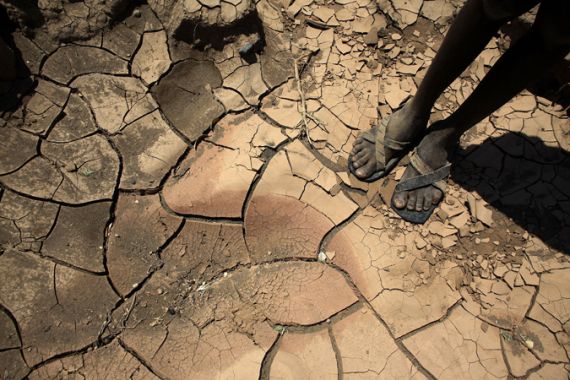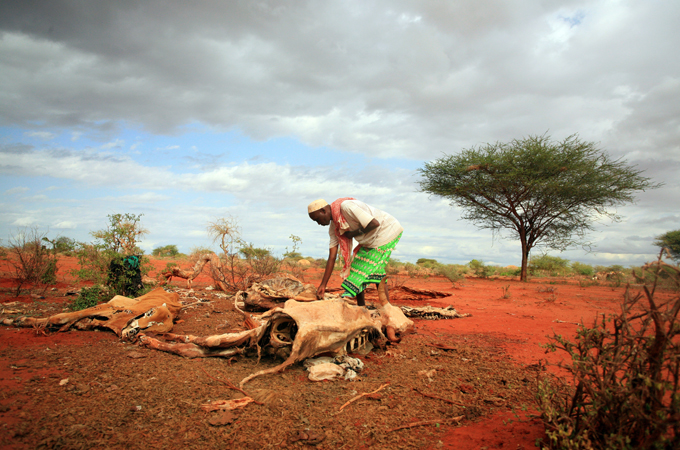East Africa: ‘It’s because of the drought’
Climate change is causing devastating droughts across East Africa – leading to an end of the pastoral way of life.

 |
| Many tribes across East Africa are having to leave their pastoral way of life for urban poverty because of severe droughts [Andrew Wander/Save the Children] |
Whether you ask about the carcasses of livestock baked white in the sun, the gaggle of people crowding around the district commissioner’s door, or the wards of malnourished children lying listlessly in hospital beds, the explanation given is always the same.
“It’s because of the drought”, they say.
Keep reading
list of 4 itemsAfter the Hurricane
World’s coral reefs face global bleaching crisis
Why is Germany maintaining economic ties with China?
The failure of rains across arid parts of East Africa has brought misery to millions of people, affecting almost every aspect of life.
In this dry, dusty part of the world, every drop that falls helps people scrape a living from the land. If the rains don’t come for a season people go hungry. If they fail twice in a row, as they have in Kenya’s impoverished north eastern province, they begin to starve.
At the hospital in Wajir town, the paediatric ward is full of young mothers clutching the tiny, wasted forms of their children.
Doctors estimate admissions for severe malnutrition in children have risen by at least 25 per cent in recent months, and fear that the dozens of referrals they have seen could be the tip of a large and deadly iceberg.
“Some parents are reluctant to bring their children to the hospital because it is such a long journey, or they don’t recognise the symptoms of malnutrition. Some think they can cure the problem by praying – they don’t realise the children need treatment. Children could be dying because of this and we wouldn’t know about it,” says Dr Moses Menza, the chief medical officer at the hospital.
He is talking at the bedside of two-year old Bashara, the daughter of nomadic cattle grazers who wander the desert four hours to the west of Wajir town. There is no need for Menza to explain what is wrong with her; her sunken features and twig-like limbs tell their own desperate tale.
Bashara is here with her grandmother, Amina Mohamed; her parents left her in the village and drove their animals to more fertile ground as the drought began to bite. She should have been safer there than out on the plains, but when the livestock began to die, the villagers found themselves with nothing to feed their families.
As always, it was growing children like Bashara who were hit hardest.
“The animals are the way we earn money and how we get food,” Amina says, as she waves the flies off the starving child’s tiny face. “Now they have died we have nothing to eat and nothing to sell. We have no milk any more, so we cannot feed the children.”
Save the Children has treated thousands of drought-affected children for malnutrition in Kenya alone, and believes that across the region, in neighbouring Somalia and Ethiopia, more than millions of children could be at risk over the next three months.
“When these people lose their livestock, they lose their source of food, their livelihood and their savings in a single stroke,” said Matt Croucher, Save the Children’s regional emergency manager for East Africa.
“We can only imagine the desperation such families feel at not being able to give their children enough to eat and drink to stay healthy. They need help now, before this crisis turns into a catastrophe.”
Changing climate
East Africans are no strangers to drought conditions. Traditionally, the rains here have failed around once a decade, giving communities time to build up emergency stocks and to restore the condition of their livestock on the good years. But for the past decade, droughts have been coming more regularly.
The people here reckon the rains fail one year in every two now; consecutive failings, like this one, have the potential to totally destroy the herds upon which they rely.
With their prime assets gone, they lose both their source of food, and their sole source of income. Their nomadic lifestyle prevents them from growing crops; the animals they graze are their only means to survive. Now it appears that climate change is robbing them of that livelihood.
A study by the US Geological Survey, published earlier this year, linked the increased frequency of drought in East Africa with global warming, suggesting that there is more than bad luck behind the latest wave of hunger sweeping the region.
Faced with a changing climate increasing numbers of pastoralists are leaving the land, settling in permanent communities on the edge of towns like Wajir. A way of life that has persisted for thousands of years is slowly dying out.
Those who leave will find little in the way of work in the towns. That pastoralists are willing to opt for grinding urban poverty over the only work they have ever known is a testament to how bad the situation has become.
For those who remain, the next few months will be critical.
The next rains are not expected until October, and with livestock dying every day, the situation looks set to get worse before it gets better. Aid operations are chronically underfunded; Save the Children has less than half of the money it needs to respond to this crisis effectively.
In rural villages, there are already reports of children dying as a result of the extreme hardship they face.
Abdullah Alnoor lives in the remote village of Haragel, two hours drive from Wajir town. In April his two year-old son, Mohamed, died of pneumonia, after living almost all of his short life under drought conditions. Abdullah blames the changing climate for his son’s death.
“He was born in a drought, and his mother was sick while she was pregnant with him. When he was born he was not well; he was a very weak child. Then two months ago he became ill again, and could not survive.”
He pauses for a moment and shakes his head before uttering a familiar refrain. “It was because of the drought,” he says.